Subscriber Exclusive
Tweeds, Heathers, and Marls—What’s the Difference and What to Knit
Classic yarns, complex colors
Classic yarns, complex colors <a href="https://farmfiberknits.com/tweeds-heathers-and-marls-the-difference/">Continue reading.</a>
https://farmfiberknits.com/cdn-cgi/image/format=auto/https://www.datocms-assets.com/101500/1710970395-larson-header-marls-tweeds.jpg?auto=format&w=900
Just the mention of tweed or heathered yarns can turn many a knitter’s head. These classic woolly skeins often appear as complex solid colors from afar and brilliantly multicolored when inspected up close. Heathers, tweeds, and marls, too, are traditionally “dyed in the wool.” This means that the dyeing steps happen before the yarn is spun into its final form.
All three of these yarn styles traditionally incorporate this approach—dyeing the ingredients before the final yarn is spun—but in different ways that create special color and (sometimes) texture effects. Heathers, tweeds, and marls are all related, and like most textile terms, meanings can shift over time. You may encounter modern yarns that don’t fall neatly into these categories or might be described by the makers using different terms. Think of this as a framework of traditional terms as we dissect some currently produced, wonderfully polychrome yarns.
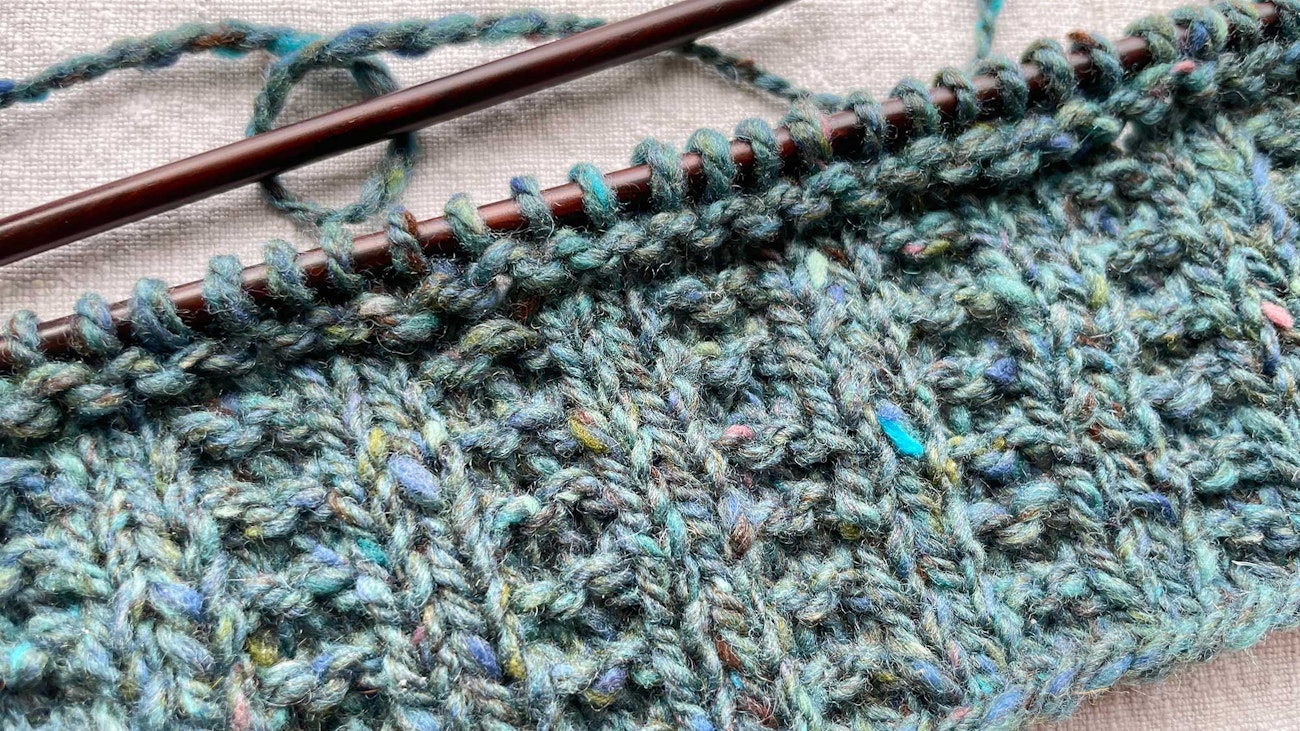 Lucky Tweed from Kelbourne Woolens (Ocean colorway) works up beautifully in the garter-rib brim of the Leaf Cap (see below).
Lucky Tweed from Kelbourne Woolens (Ocean colorway) works up beautifully in the garter-rib brim of the Leaf Cap (see below).
Choosing a pattern for yarns that incorporate many colors and some occasional texture can be a knitter's challenge. Strong stitch motifs and cables with a three-dimentional relief can help make your careful stitching pop. We've curated three pattern suggestions from our library that would work with the worsted-weight yarns featured here. Subscribers will find links to each pattern in the library below.
Heathers
The gentle varieation of heathered yarns happens in the blending step. Different colors of dyed or undyed fibers are mixed together before spinning. The more thoroughly blended, the more solid the color will appear. Describing a color as “heathered” is a fairly ubiquitous term, so where did it come from? According to Fairchild’s Dictionary of Textiles, “the term originally suggested the purplish color of Scottish heather, yet many heather mixtures today do not simulate this hue.”
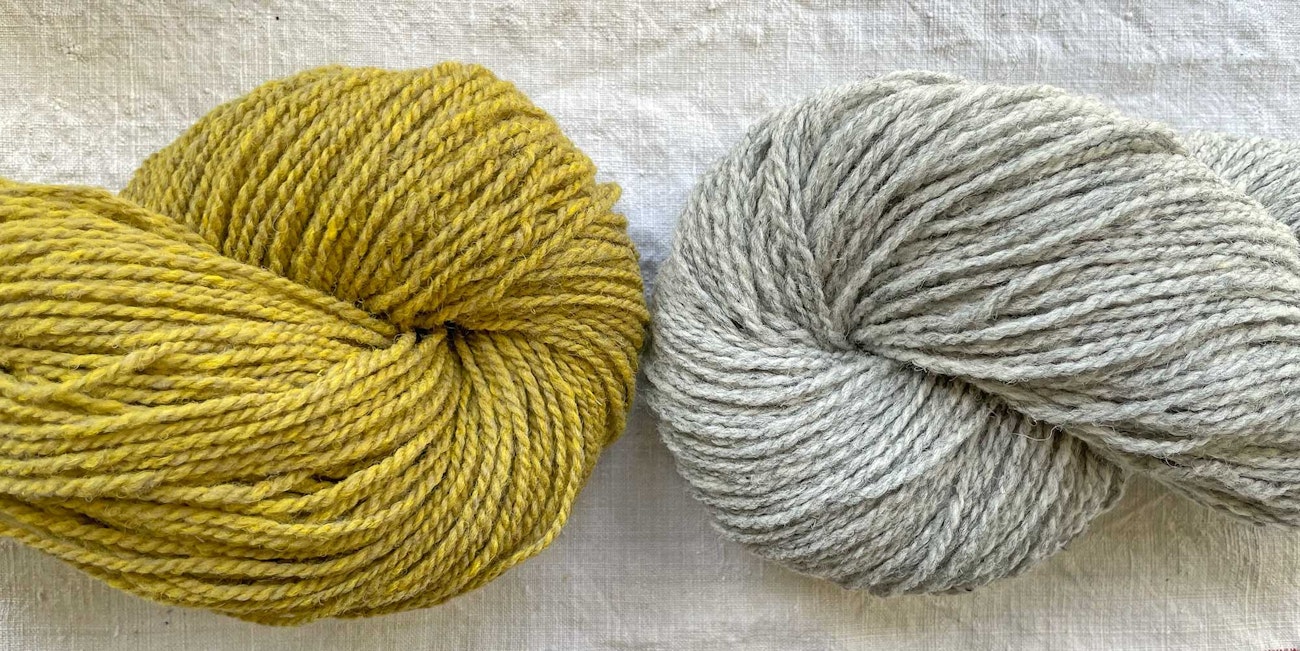 Harrisville Designs Highland worsted in Tundra (left) and Silver Mist (right)
Harrisville Designs Highland worsted in Tundra (left) and Silver Mist (right)
The Tundra colorway is a heathered blend of sunny yellow and what appears to be a gray that leans to tan. This creates a complex yet consistent color that won’t compete with cables or complicated stitch patterns. The same blending approach using white and black fiber yields the soft gray, granite-like effect shown here.
SUBSCRIBER EXCLUSIVE
Just the mention of tweed or heathered yarns can turn many a knitter’s head. These classic woolly skeins often appear as complex solid colors from afar and brilliantly multicolored when inspected up close. Heathers, tweeds, and marls, too, are traditionally “dyed in the wool.” This means that the dyeing steps happen before the yarn is spun into its final form.
All three of these yarn styles traditionally incorporate this approach—dyeing the ingredients before the final yarn is spun—but in different ways that create special color and (sometimes) texture effects. Heathers, tweeds, and marls are all related, and like most textile terms, meanings can shift over time. You may encounter modern yarns that don’t fall neatly into these categories or might be described by the makers using different terms. Think of this as a framework of traditional terms as we dissect some currently produced, wonderfully polychrome yarns.
 Lucky Tweed from Kelbourne Woolens (Ocean colorway) works up beautifully in the garter-rib brim of the Leaf Cap (see below).
Lucky Tweed from Kelbourne Woolens (Ocean colorway) works up beautifully in the garter-rib brim of the Leaf Cap (see below).
Choosing a pattern for yarns that incorporate many colors and some occasional texture can be a knitter's challenge. Strong stitch motifs and cables with a three-dimentional relief can help make your careful stitching pop. We've curated three pattern suggestions from our library that would work with the worsted-weight yarns featured here. Subscribers will find links to each pattern in the library below.
Heathers
The gentle varieation of heathered yarns happens in the blending step. Different colors of dyed or undyed fibers are mixed together before spinning. The more thoroughly blended, the more solid the color will appear. Describing a color as “heathered” is a fairly ubiquitous term, so where did it come from? According to Fairchild’s Dictionary of Textiles, “the term originally suggested the purplish color of Scottish heather, yet many heather mixtures today do not simulate this hue.”
 Harrisville Designs Highland worsted in Tundra (left) and Silver Mist (right)
Harrisville Designs Highland worsted in Tundra (left) and Silver Mist (right)
The Tundra colorway is a heathered blend of sunny yellow and what appears to be a gray that leans to tan. This creates a complex yet consistent color that won’t compete with cables or complicated stitch patterns. The same blending approach using white and black fiber yields the soft gray, granite-like effect shown here.
[PAYWALL]
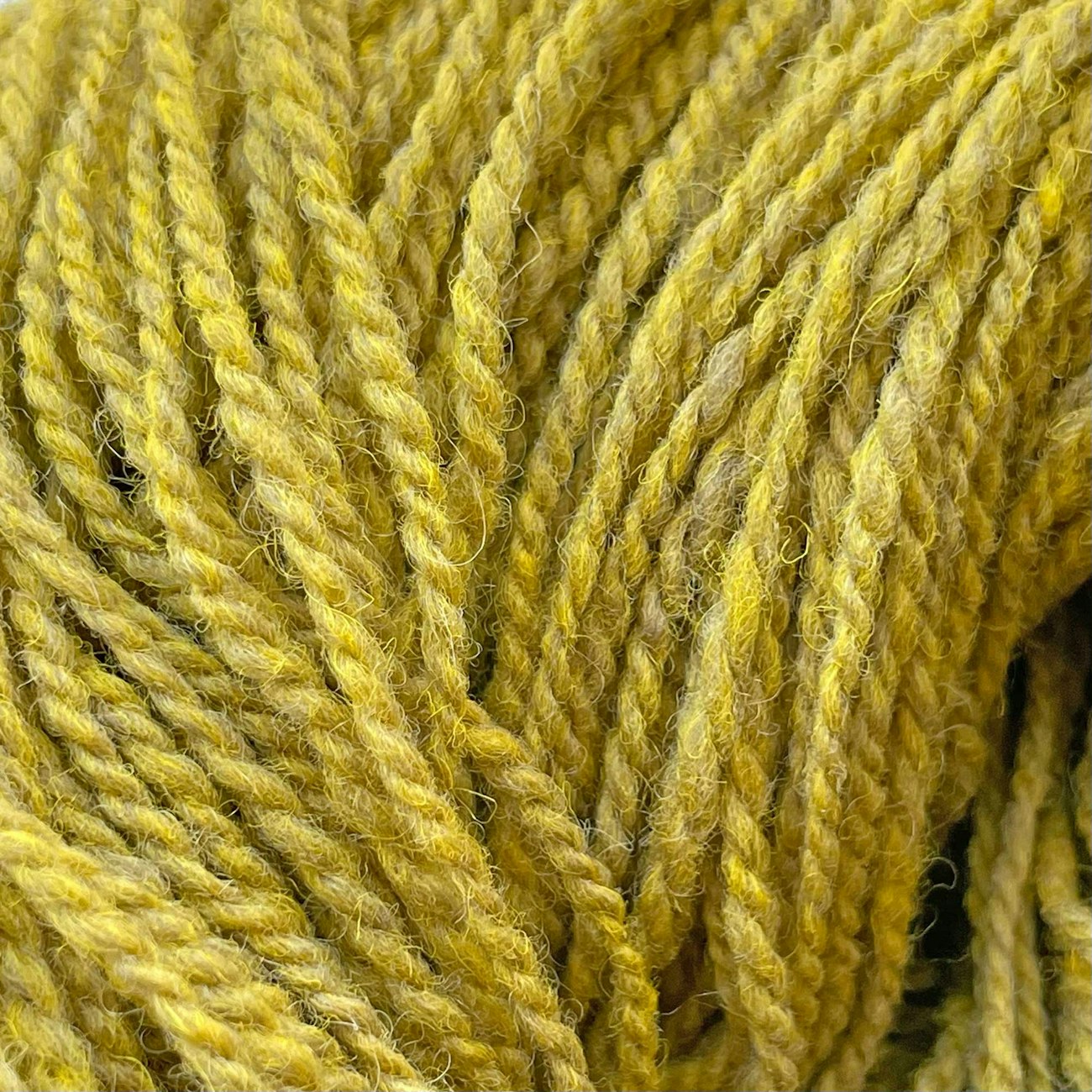 A close look reveals the component colors: yellow and gray/tan
A close look reveals the component colors: yellow and gray/tan
Tweeds
While “tweed” originally referred to woven fabrics that we still see in tweed jackets and such today, we also use the term to describe yarn with the same look. Irish tweeds and Donegal tweeds are often what first comes to mind.
Donegal tweeds take what we know about heathered yarns—a mixture of different colored fibers—and adds additional pops of colors. Nepps are short, often somewhat tangled fibers that can be dyed in bright colors and added to longer fibers during blending. Just like heathers, the secret is in just how much blending occurs—too little and the nepps will not be secured in the yarn, too much and the colors can become muted and lost. See pictures of the mill process in action in this post by Melissa Weaver-Dunning.
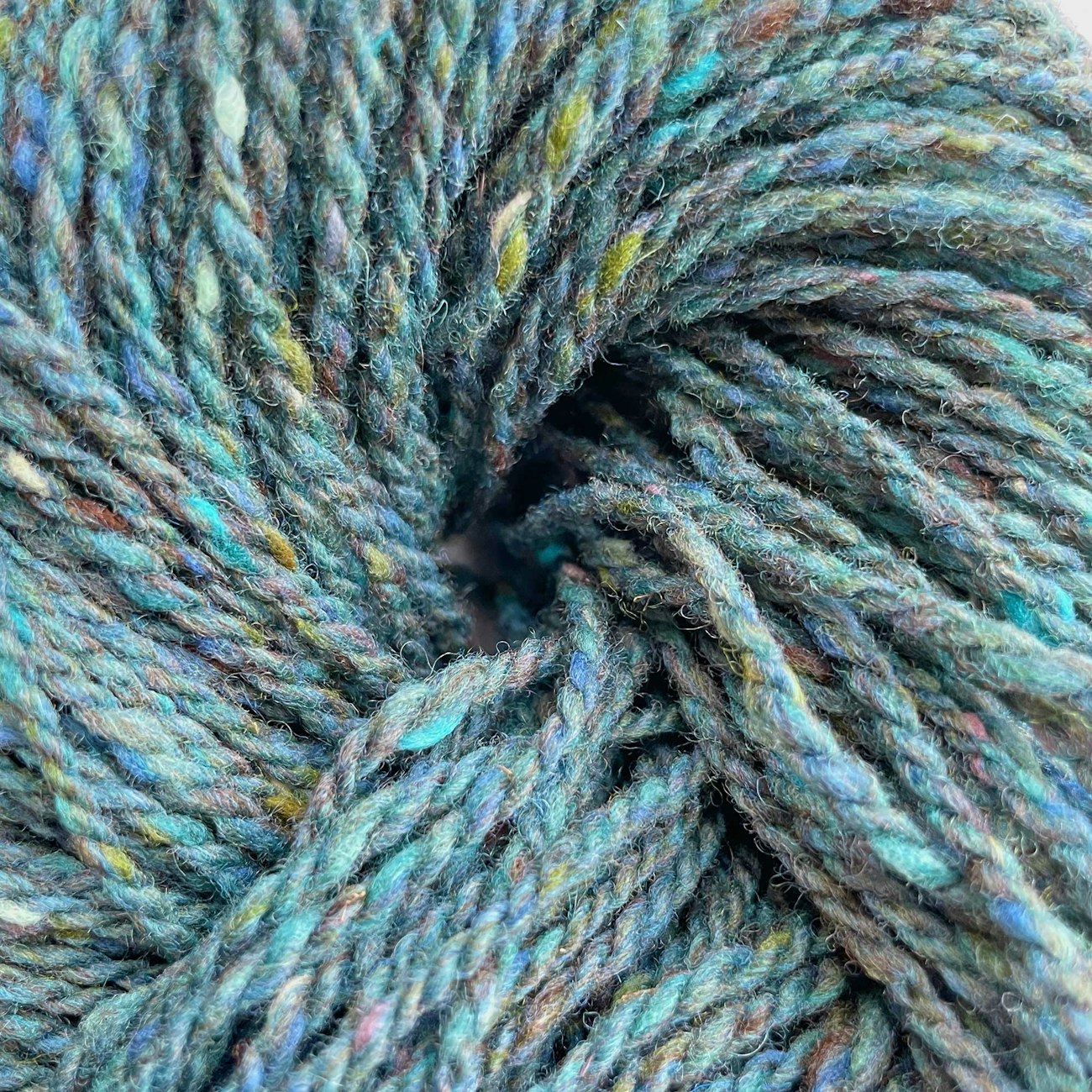 Tweeds can come in a variety of effects, ranging from sharp, textured pops of color to more subdued consistent color and texture. Lucky Tweed is a happy balance of the two extremes.
Tweeds can come in a variety of effects, ranging from sharp, textured pops of color to more subdued consistent color and texture. Lucky Tweed is a happy balance of the two extremes.
Marls
Marls are the next stop on our dyed-in-the-wool journey, and they often combine elements of both heathers and tweeds to create even more color fun. Fairchild’s Dictionary describes a marl as having different colored strands combined when the singles are spun or during plying. Basically, it means that different colors are swirling through the yarn.
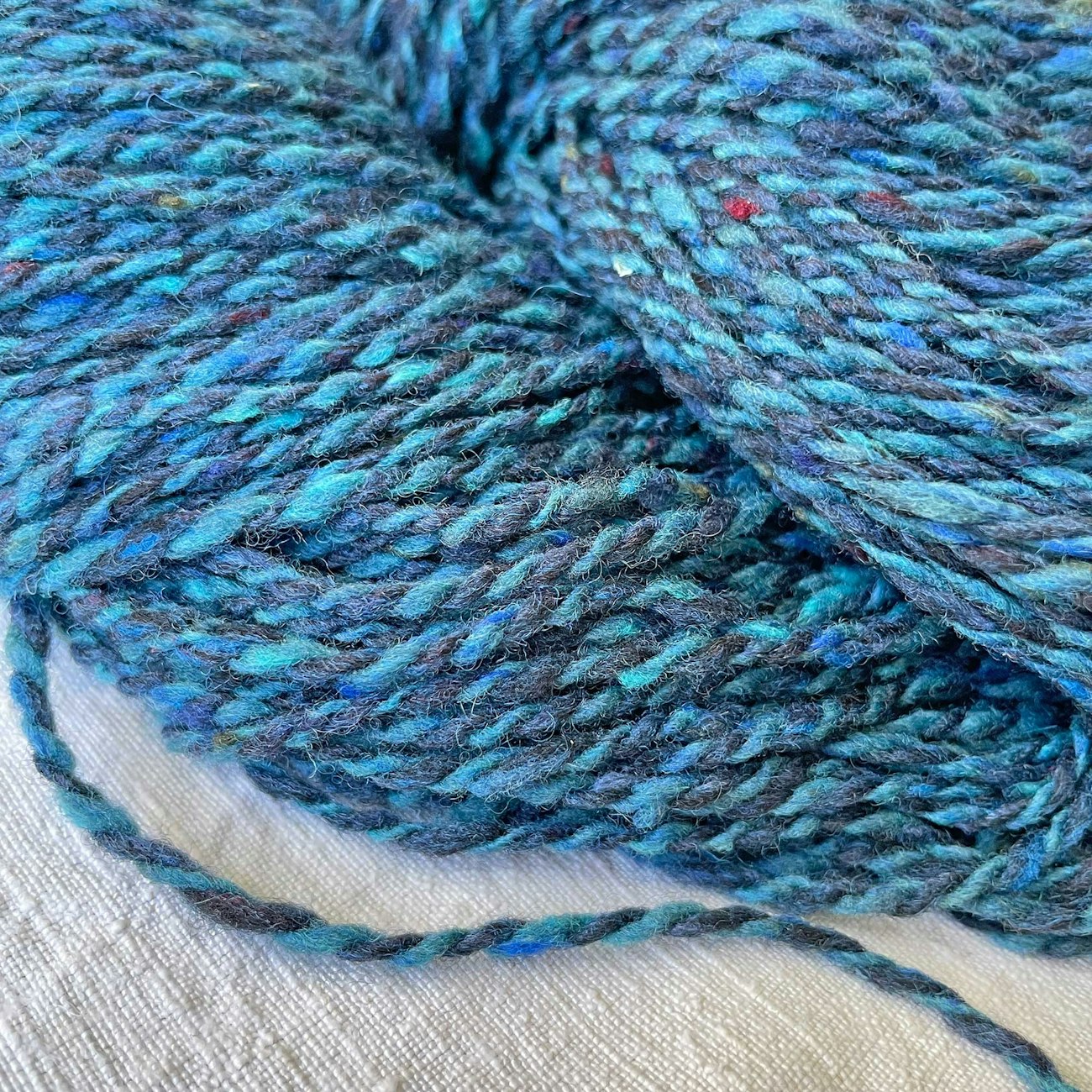 Studio Donegal’s Marl Soft yarn (read more here) is two heathered or tweed singles of different colors plied together. In stockinette stitch, the Blueberry colorway has gentle texture and fun pops and speckles of color.
Studio Donegal’s Marl Soft yarn (read more here) is two heathered or tweed singles of different colors plied together. In stockinette stitch, the Blueberry colorway has gentle texture and fun pops and speckles of color.
The yarns will often have a candy-cane effect in the skein, but when knitted, we often see it more as bright speckles of colors, which is why Fairchild’s also says this can be called a “mottle yarn.”
Marls are popular in knitting again, and it’s exciting to see how many different options we have today—subdued color or sharp contrasts, dyed in the wool or hand-dyed singles that are later plied at the mill. But they all have deep roots in our textile history, tangled though they may be.
Great Projects to Cast On!
We selected a few patterns in the Farm and Fiber Knits library that use worsted-weight yarns like those featured in this article. We hope you will be inspired to cast on your next knit!
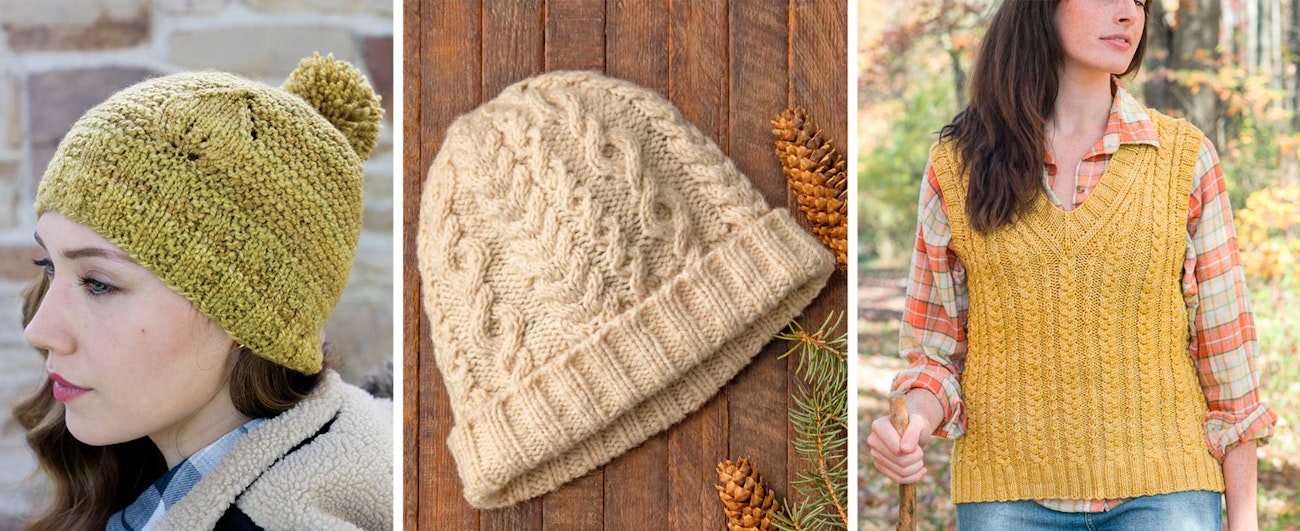 Shown left to right: Leaf Cap (photo by George Boe), Towline Hat (photo by Matt Graves), and Vest for the Cricket Match (photo by Gale Zucker)
Shown left to right: Leaf Cap (photo by George Boe), Towline Hat (photo by Matt Graves), and Vest for the Cricket Match (photo by Gale Zucker)
Leaf Cap by Melissa LeBarre
Towline Hat by Kerry Bullock-Ozkan
Vest for the Cricket Match by Annie Modesitt
Resources
Tortora, Phyllis G. and Robert S. Merkel. Fairchild’s Dictionary of Textiles. 7th ed. New York: Fairchild Publications, 2009.
 Lucky Tweed from Kelbourne Woolens (Ocean colorway) works up beautifully in the garter-rib brim of the Leaf Cap (see below).
Lucky Tweed from Kelbourne Woolens (Ocean colorway) works up beautifully in the garter-rib brim of the Leaf Cap (see below).  Harrisville Designs Highland worsted in Tundra (left) and Silver Mist (right)
Harrisville Designs Highland worsted in Tundra (left) and Silver Mist (right) 

 A close look reveals the component colors: yellow and gray/tan
A close look reveals the component colors: yellow and gray/tan  Tweeds can come in a variety of effects, ranging from sharp, textured pops of color to more subdued consistent color and texture. Lucky Tweed is a happy balance of the two extremes.
Tweeds can come in a variety of effects, ranging from sharp, textured pops of color to more subdued consistent color and texture. Lucky Tweed is a happy balance of the two extremes.  Studio Donegal’s Marl Soft yarn (
Studio Donegal’s Marl Soft yarn ( Shown left to right: Leaf Cap (photo by George Boe), Towline Hat (photo by Matt Graves), and Vest for the Cricket Match (photo by Gale Zucker)
Shown left to right: Leaf Cap (photo by George Boe), Towline Hat (photo by Matt Graves), and Vest for the Cricket Match (photo by Gale Zucker)